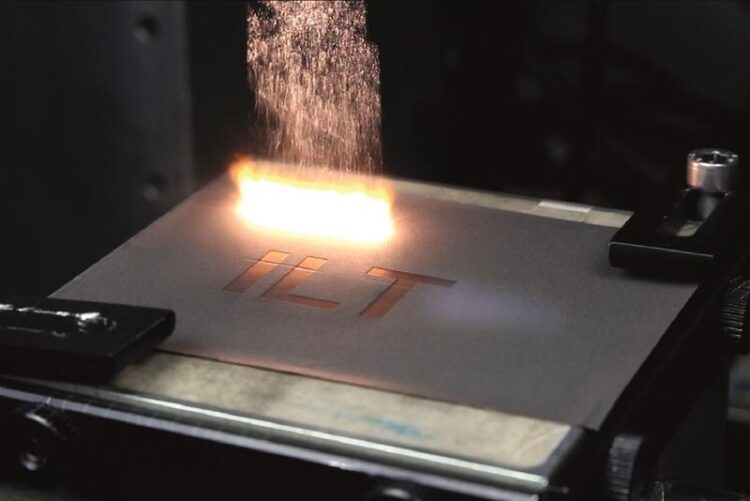More flexible battery design with ultrafast laser ablation

The Fraunhofer ILT has come up with a process tailor-made to ablate anode material from very thin copper foils at up to 1760 mm³/min. It uses a powerful USP laser to expose surfaces for electrical contacts.
© Fraunhofer ILT, Aachen, Germany
The ultrashort pulse (USP) laser has been known to shine whenever highly sensitive material needs to be machined quickly yet gently. The Fraunhofer Institute for Laser Technology ILT has investigated one such application that certainly looks to have a bright future: The Aachen-based researchers developed a quick, reliable and nondestructive method of ablating lithium-ion batteries’ anode material with an ultrashort pulsed laser beam. This ablation technique exposes electrical contact points called tabs.
A more flexible way of producing diverse electrodes
Lithium-ion batteries are not only essential to electric vehicles; they also power consumer electronic devices such as tablets and smartphones. Manufacturing a wide variety of battery formats on a single production line poses a great technical challenge for battery vendors; even more so now that this has to be done more productively than ever before. Coating the metallic substrate foil with active material is a key step in this production process. This coating is a wafer-thin layer of paste applied to copper or aluminum foil that is just a few micrometers thick. Designated areas of the metal foil have to remain uncoated to provide an electrical contact for the electrodes. The coating process has to be interrupted and restarted repeatedly to create these tabs.
It takes a swift process to speed up electrode production
This technical challenge is growing even more daunting as new applications emerge and penetrate the market, driving demand for lithium-ion batteries in increasingly diverse sizes and shapes. The electrode production line has to be fast and flexible to rise to that challenge. Coating just some of the foil’s surface is a very complex matter, so one way of resolving this issue is to coat the entire surface, and then apply a laser beam to expose just the areas needed for electrical contacts.
“Production line conveyor belts generally run at speeds of around 60 m/min,” says Dr. Karsten Lange, a research fellow with the Micro- and Nano-Structuring Group at Fraunhofer ILT. “The idea of exposing these areas with a laser had failed in the past due to a lack of productivity on the part of the ablation process. What’s more, the quality of laser ablation did not meet the high standards for a contact point that could be welded easily.”
New USP process is fast, gentle and precise
To make matters even more difficult, substrate foils are very thin – generally from 6 to no more than 15 micrometers. This is why the laser process has to expose contact points in a highly productive way, without leaving any residue or damaging the delicate substrate foils. The Fraunhofer ILT opted for a powerful USP laser with those requirements in mind. “The challenge is to remove the entire layer of active material in one pass without leaving any residue – and without damaging the thin metal foil,” says Lange.
“The process we have developed enables us to apply a USP laser to remove graphite-based anode material from 10-micrometer-thin copper foil at a rate of up to 1760 mm³/min without damaging it.” In the near future, it will be possible to push the ablation rates even further by using the new generation of ultrafast laser systems with multi-kW output power with are currently developed in the Fraunhofer Cluster of Excellence Advanced Photon Sources CAPS.
Partner sought for further development
Now that laser ablation has proven its merits in the lab, the Fraunhofer ILT is looking forward to develop the process further to ramp it up for mass manufacturing. “Therefore, we recently installed a high-power USP laser system that is integrated into a roll-to-roll system, which gives us the opportunity to investigate laser ablation in a continuous process,” says Lange. “We are now looking for partners to further develop USP laser ablation in an industry or research project.”
Wissenschaftliche Ansprechpartner:
Dr. rer. nat. Karsten Lange
Group Micro- and Nano Structuring
Telephone +49 241 8906-8442
karsten.lange@ilt.fraunhofer.de
Dipl.-Phys. Martin Reininghaus
Group Manager Micro- and Nano Structuring
Telephone +49 241 8906-627
martin.reininghaus@ilt.fraunhofer.de
Weitere Informationen:
Media Contact
All latest news from the category: Power and Electrical Engineering
This topic covers issues related to energy generation, conversion, transportation and consumption and how the industry is addressing the challenge of energy efficiency in general.
innovations-report provides in-depth and informative reports and articles on subjects ranging from wind energy, fuel cell technology, solar energy, geothermal energy, petroleum, gas, nuclear engineering, alternative energy and energy efficiency to fusion, hydrogen and superconductor technologies.
Newest articles

You are What You Eat—Stanford Study Links Fiber to Anti-Cancer Gene Modulation
The Fiber Gap: A Growing Concern in American Diets Fiber is well known to be an important part of a healthy diet, yet less than 10% of Americans eat the minimum recommended…

Trust Your Gut—RNA-Protein Discovery for Better Immunity
HIRI researchers uncover control mechanisms of polysaccharide utilization in Bacteroides thetaiotaomicron. Researchers at the Helmholtz Institute for RNA-based Infection Research (HIRI) and the Julius-Maximilians-Universität (JMU) in Würzburg have identified a…

ASXL1 Mutation: The Hidden Trigger Behind Blood Cancers and Inflammation
Scientists show how a mutated gene harms red and white blood cells. LA JOLLA, CA—Scientists at La Jolla Institute for Immunology (LJI) have discovered how a mutated gene kicks off…



